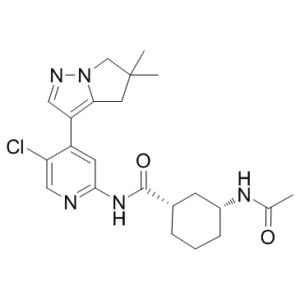AZD4573 (AZD-4573) is a novel, potent and short acting inhibitor of serine/threonine CDK9 (cyclin-dependent kinase 9, IC50<0.004 μM) with potential anticancer activities. It has strong selectivity against other kinases, including those in the CDK family, and fast-off binding kinetics (t1/2 = 16 min). A variety of anti-apoptotic proteins' gene transcription is inhibited when AZD4573 binds to CDK9 and inhibits its phosphorylation and kinase activity. This prevents PTEFb-mediated activation of RNA Pol II.
Physicochemical Properties
| Molecular Formula | C22H28CLN5O2 | |
| Molecular Weight | 429.9430 | |
| Exact Mass | 429.19 | |
| Elemental Analysis | C, 61.46; H, 6.56; Cl, 8.25; N, 16.29; O, 7.44 | |
| CAS # | 2057509-72-3 | |
| Related CAS # | 2057509-72-3;Unknown (HCl); | |
| PubChem CID | 124155204 | |
| Appearance | White to off-white solid powder | |
| LogP | 2.7 | |
| Hydrogen Bond Donor Count | 2 | |
| Hydrogen Bond Acceptor Count | 4 | |
| Rotatable Bond Count | 4 | |
| Heavy Atom Count | 30 | |
| Complexity | 659 | |
| Defined Atom Stereocenter Count | 2 | |
| SMILES | CC(=O)N[C@@H]1CCC[C@@H](C1)C(=O)NC2=NC=C(C(=C2)C3=C4CC(CN4N=C3)(C)C)Cl |
|
| InChi Key | AVIWDYSJSPOOAR-LSDHHAIUSA-N | |
| InChi Code | InChI=1S/C22H28ClN5O2/c1-13(29)26-15-6-4-5-14(7-15)21(30)27-20-8-16(18(23)11-24-20)17-10-25-28-12-22(2,3)9-19(17)28/h8,10-11,14-15H,4-7,9,12H2,1-3H3,(H,26,29)(H,24,27,30)/t14-,15+/m0/s1 | |
| Chemical Name | (1S,3R)-3-acetamido-N-[5-chloro-4-(5,5-dimethyl-4,6-dihydropyrrolo[1,2-b]pyrazol-3-yl)pyridin-2-yl]cyclohexane-1-carboxamide | |
| Synonyms |
|
|
| HS Tariff Code | 2934.99.9001 | |
| Storage |
Powder-20°C 3 years 4°C 2 years In solvent -80°C 6 months -20°C 1 month |
|
| Shipping Condition | Room temperature (This product is stable at ambient temperature for a few days during ordinary shipping and time spent in Customs) |
Biological Activity
| Targets | CDK9 (IC50 = 4 nM) |
| ln Vitro | AZD4573 treatment for a brief period of time resulted in a fast dose- and time-dependent reduction in cellular pSer2-RNAPII, which in turn activated caspase 3 and induced cell death in a variety of haematological cancer cell lines (for example, caspase activation EC50 13.7 nM in an acute myeloid leukemia model MV4-11) [1]. |
| ln Vivo | AZD4573 has a short half-life (less than an hour in the case of rats, dogs, and monkeys) and is well soluble when administered intravenously[1]. |
| Cell Assay | Specific drug concentrations were applied to the cells. |
| Animal Protocol |
Nomo-1 AML xenograft 5 mg/kg i.p. |
| References |
[1]. Abstract 1650: Discovery of AZD4573, a potent and selective inhibitor of CDK9 that enables transient target engagement for the treatment of hematologic malignancies. Cancer Research. July 2018. 78(13): Supplement. |
| Additional Infomation | Zemirciclib is a selective, short-acting inhibitor of the serine/threonine cyclin-dependent kinase 9 (CDK9), the catalytic subunit of the RNA polymerase II (RNA Pol II) elongation factor positive transcription elongation factor b (PTEF-b; PTEFb), with potential antineoplastic activity. Upon intravenous administration, zemirciclib binds to and blocks the phosphorylation and kinase activity of CDK9, thereby preventing PTEFb-mediated activation of RNA Pol II, leading to the inhibition of gene transcription of various anti-apoptotic proteins. This induces cell cycle arrest and apoptosis, and leads to a reduction in tumor cell proliferation. CDK9 regulates elongation of transcription through phosphorylation of RNA polymerase II at serine 2 (p-Ser2-RNAPII). It is upregulated in various tumor cell types and plays a key role in the regulation of Pol II-mediated transcription of anti-apoptotic proteins. Tumor cells are dependent on anti-apoptotic proteins for their survival. |
Solubility Data
| Solubility (In Vitro) |
|
|||
| Solubility (In Vivo) |
Solubility in Formulation 1: ≥ 2.08 mg/mL (4.84 mM) (saturation unknown) in 10% DMSO + 40% PEG300 + 5% Tween80 + 45% Saline (add these co-solvents sequentially from left to right, and one by one), clear solution. For example, if 1 mL of working solution is to be prepared, you can add 100 μL of 20.8 mg/mL clear DMSO stock solution to 400 μL PEG300 and mix evenly; then add 50 μL Tween-80 to the above solution and mix evenly; then add 450 μL normal saline to adjust the volume to 1 mL. Preparation of saline: Dissolve 0.9 g of sodium chloride in 100 mL ddH₂ O to obtain a clear solution. Solubility in Formulation 2: ≥ 2.08 mg/mL (4.84 mM) (saturation unknown) in 10% DMSO + 90% (20% SBE-β-CD in Saline) (add these co-solvents sequentially from left to right, and one by one), clear solution. For example, if 1 mL of working solution is to be prepared, you can add 100 μL of 20.8 mg/mL clear DMSO stock solution to 900 μL of 20% SBE-β-CD physiological saline solution and mix evenly. Preparation of 20% SBE-β-CD in Saline (4°C,1 week): Dissolve 2 g SBE-β-CD in 10 mL saline to obtain a clear solution. Solubility in Formulation 3: ≥ 2.08 mg/mL (4.84 mM) (saturation unknown) in 10% DMSO + 90% Corn Oil (add these co-solvents sequentially from left to right, and one by one), clear solution. For example, if 1 mL of working solution is to be prepared, you can add 100 μL of 20.8 mg/mL clear DMSO stock solution to 900 μL of corn oil and mix evenly. (Please use freshly prepared in vivo formulations for optimal results.) |
| Preparing Stock Solutions | 1 mg | 5 mg | 10 mg | |
| 1 mM | 2.3259 mL | 11.6295 mL | 23.2591 mL | |
| 5 mM | 0.4652 mL | 2.3259 mL | 4.6518 mL | |
| 10 mM | 0.2326 mL | 1.1630 mL | 2.3259 mL |
